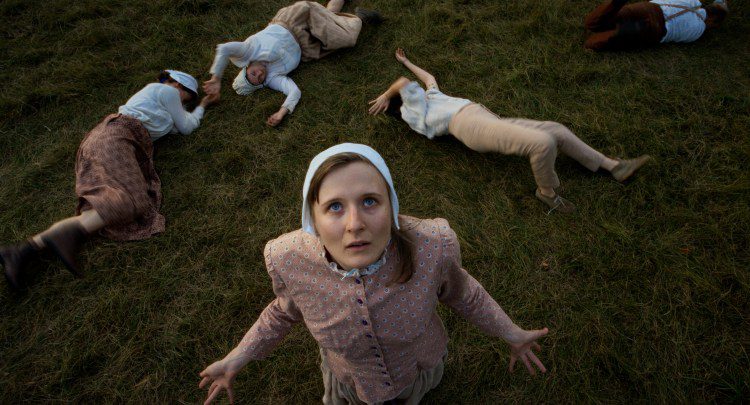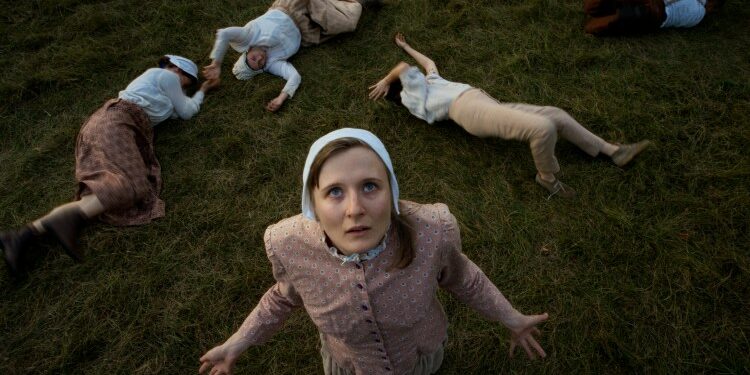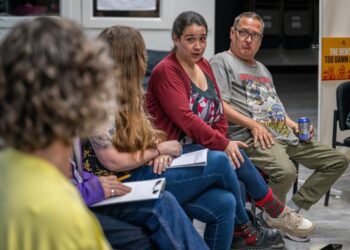

A scene from the Maine-set and -shot doomsday film “Those Who Wait.” Photo courtesy of Chani Bockwinkel and Ty Burdenski
What would you do if you knew the world was ending? Like, if you just knew it.
It’s not just idle speculation for Mainers, since one of the most popular doomsday cults in history happened here, with its strongest outposts located right in Portland.
Sure, we’re talking about the 1840s, but “Those Who Wait,” a bold and fascinating new film from co-directors Chani Bockwinkel and Ty Burdenski, isn’t shy about drawing parallels to today. Screening Saturday at Portland’s Space, the film suggests that modern America has more in common with the film’s real-life Millerite doomsday community than we’d like to admit.
Just who were the Millerites?
William Miller was a Massachusetts-born preacher whose experience with an artillery shell in the War of 1812 convinced him to take a closer look at God. Biblical calculations led Miller to conclude that the second coming of Christ – with all the fire and extinction-level chaos Evangelicals insist that entails – would occur on Aug. 22, 1844. (The failure of the world to end in cleansing flame was termed “The Great Disappointment.”)
Imagining a Maine doomsday
The genesis of “Those Who Wait” kindled in the Maine art communities of Portland and Denmark. “We both had residencies at the Denmark Arts Center,” said Chani Bockwinkel, explaining that the seeds of “Those Who Wait” made the journey with the filmmakers when they received a similar residency at Portland’s Space.
“We started to have conversations about apocalyptic thinking,” explained Bockwinkel, “about just what are the circumstances that allow someone to come in and propose a whole way of looking at the world. About what’s happening socially to allow people to say yes.” Added Burdenski of the Millerites’ unique vision for the end of days, “It wasn’t just about ‘the world’s going to end,’ but came out of a desire for the world to be better.”
Wait, is there such a thing as an optimistic doomsday cult?
In its way, according to the filmmakers, the Millerites largely bucked our stereotypical visions of doomsday cults. “In a political sense, we tend to think about how conservative Christianity always has something of a doomsday edge to it,” said Burdenski, who grew up in the care of Seventh Day Adventists. “But Millerism largely grew out of the abolitionist movement. The film is a way of thinking about how the left, too, had roots in what at the time was not a casual position.”
Advocates for the immediate abolition of slavery were, in the early 1800s, radicals, demanding that the institution of owning other people be abolished in one righteous swoop. To our modern ears, the moral rightness of abolitionists’ call was obvious. To abolitionists facing opposition not just from hard-core enslavers but also peers urging a “slow and steady” walk back from slavery, their frustration was ripe for Miller’s vision of a corrupt and blinkered society being dramatically wiped clean.
(For people watching entrenched forces adopt a similar hostile and/or “wait and see” approach to seemingly self-evident concepts like global warming or human rights for all, perhaps the thought of pulling the plug and starting again isn’t completely alien.)
The pandemic only underscored the point.
“Filming during the height of COVID was illuminating,” said Bockwinkel. “There was this total fear of the world ending, but also this sort of relief, of wanting the world to go back to normal – but then again not normal.” Added Burdenski, “When confronted with an intractable problem where people are saying, ‘This needs to stop right now,’ there’s a dangerous attraction to the idea, ‘Let’s just be over all of this.’ Sort of an ‘escape hatch’ mentality.”
“Those Who Wait” takes a surprisingly sympathetic view of these Mainers and their ideological apocalypse.
Burdenski notes that the directors’ initial concept for “Those Who Wait” was a lot more mocking in tone, with the film gradually evolving into a more nuanced take. “I grew up hearing about prophets,” Burdenski said, “and then you’d learn about things like mercury poisoning and head injuries. But the more we learned about these people, the more we cared, and the more we thought, ‘aren’t we all a little Millerite?’ It’s a beautiful danger – the concept, ‘Let’s give up on this arrangement’ – and how do we get out of that.” He also notes that popular opinion of the time was far from understanding, with the press writing “weekly ridicule columns” that quickly turned the Millerites into a joke.
Maine proved a perfect setting for a film about waiting out the end of the world.
Filming took place in an appropriately low-tech field in Denmark and in historical Portland locations like the Longfellow House and the historical section of the Portland Museum. Even then, modern life was constantly poking its nose in, with careful framing and times of day chosen to eliminate things like traffic noise and windshield reflections from intruding on the period accuracy.
As for the Maine community being portrayed in the film, Bockwinkel and Burdenski are effusive in praising the can-do helpfulness of everyone they met, several of whom added to the film’s rich atmosphere. “Filming in Denmark, we met this guy named Terry Rhoades – who just happened to be building a farming implement museum,” said Burdenski. “We were doing our best to create this world, but having someone so knowledgeable to help us find locations and fine-tune the film’s look was amazing.”
Similarly, Bockwinkel lauds Maine musician Katherine Rhoda, whose skills on the hammer dulcimer can be heard in the score, and who brought along her own unexpected expertise. “We were thinking about the score and Katherine said, ‘Hey, would you be interested in seeing my own collection of abolitionists’ songbooks?’ It was a beautiful miracle.” Added Burdenski, “So many people brought along much more of their own research than we were expecting.”
The filmmakers note that most of the main cast and crew of “Those Who Wait” are Mainers, and that even the film’s day players had enthusiasm to spare for the project. “We’re so grateful we shot here,” said Burdenski, admitting that the filmmakers had originally envisioned Romania as the place to recreate the 19th century. “It’s one of the more special places I’ve worked. Everyone is so interested and kind.”
“Those Who Wait” is a lot more out there – and queer – than your average historical drama.
“The actual format of the film is so uncategorizable,” said Bockwinkel. “It’s not a documentary, it’s not regular narrative fiction. There are inter-titles like a silent film, but sometimes people talk. It’s about the outside-the-box-ness of the people.” Bockwinkel worked with a choreographer to visualize the often dramatic gyrations of the Millerites in their throes of religious ecstasy, and prepares viewers for “a very visually and sound-motivated film. A real theater experience.”
That vision extends to the film’s queer subtext, a thematic element the directors tie to the Millerites’ outsider status in their day. “We’re two queer people really interested in this story of how queerness can slip into the cracks,” said Bockwinkel. “Most of the cast and crew were queer folk, and that’s another interesting aspect of the film – we’re queer filmmakers who wanted to make a project that wasn’t the typical LGBTQ story.” “We’re queering history,” added Burdenski.
“Those Who Wait” is showing at Space at 7 p.m. Saturday with a Q&A from the filmmakers. Assuming the world is still there by then, of course.
Dennis Perkins is a freelance writer who lives in Auburn with his wife and cat.
Copy the Story Link
Source link : http://www.bing.com/news/apiclick.aspx?ref=FexRss&aid=&tid=66cc4bbab64040c6a691797f7e0ed801&url=https%3A%2F%2Fwww.pressherald.com%2F2024%2F08%2F26%2Fnot-quite-documentary-those-who-wait-depicts-doomsday-cult-in-maine%2F&c=10543345621919665448&mkt=en-us
Author :
Publish date : 2024-08-25 12:59:00
Copyright for syndicated content belongs to the linked Source.






